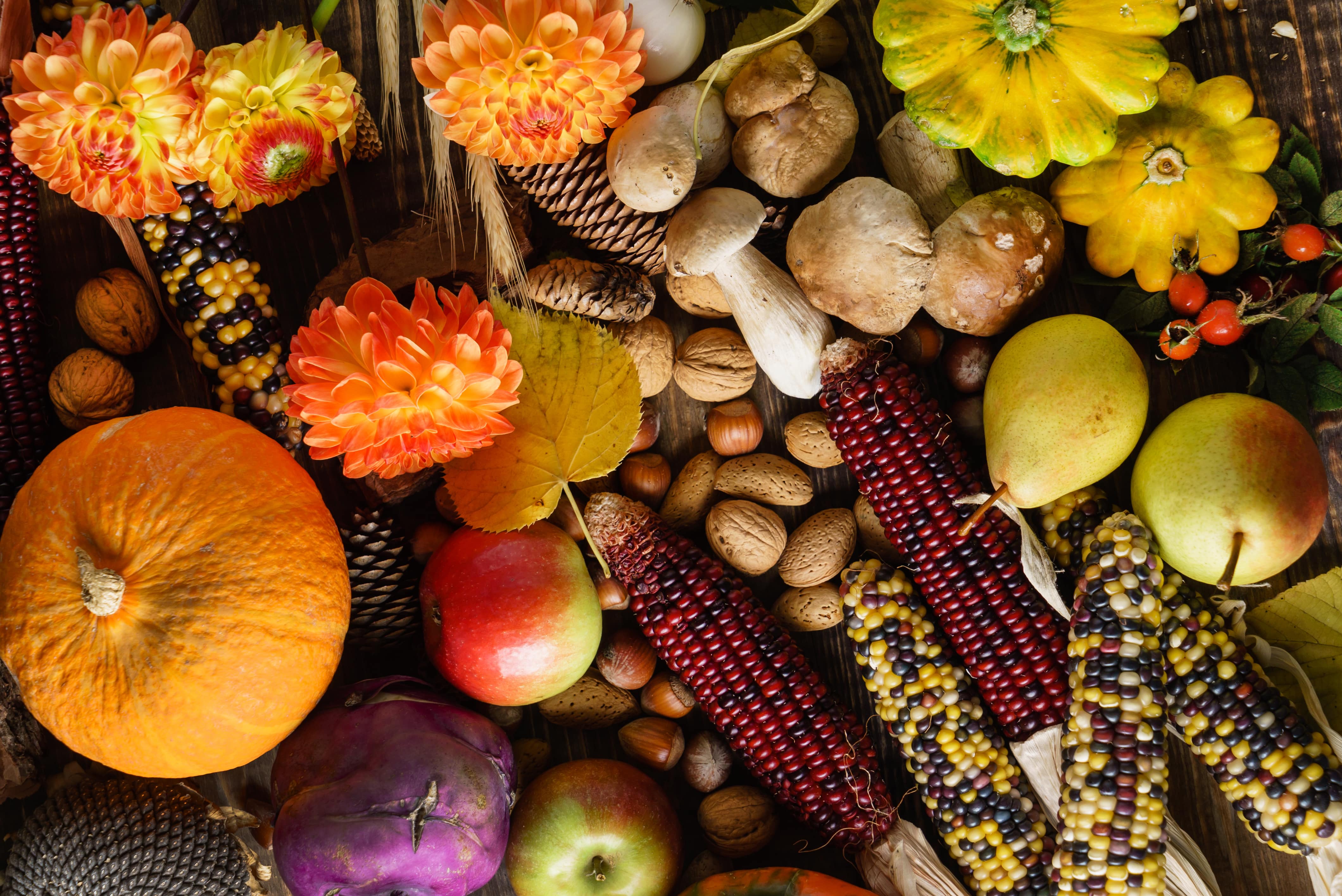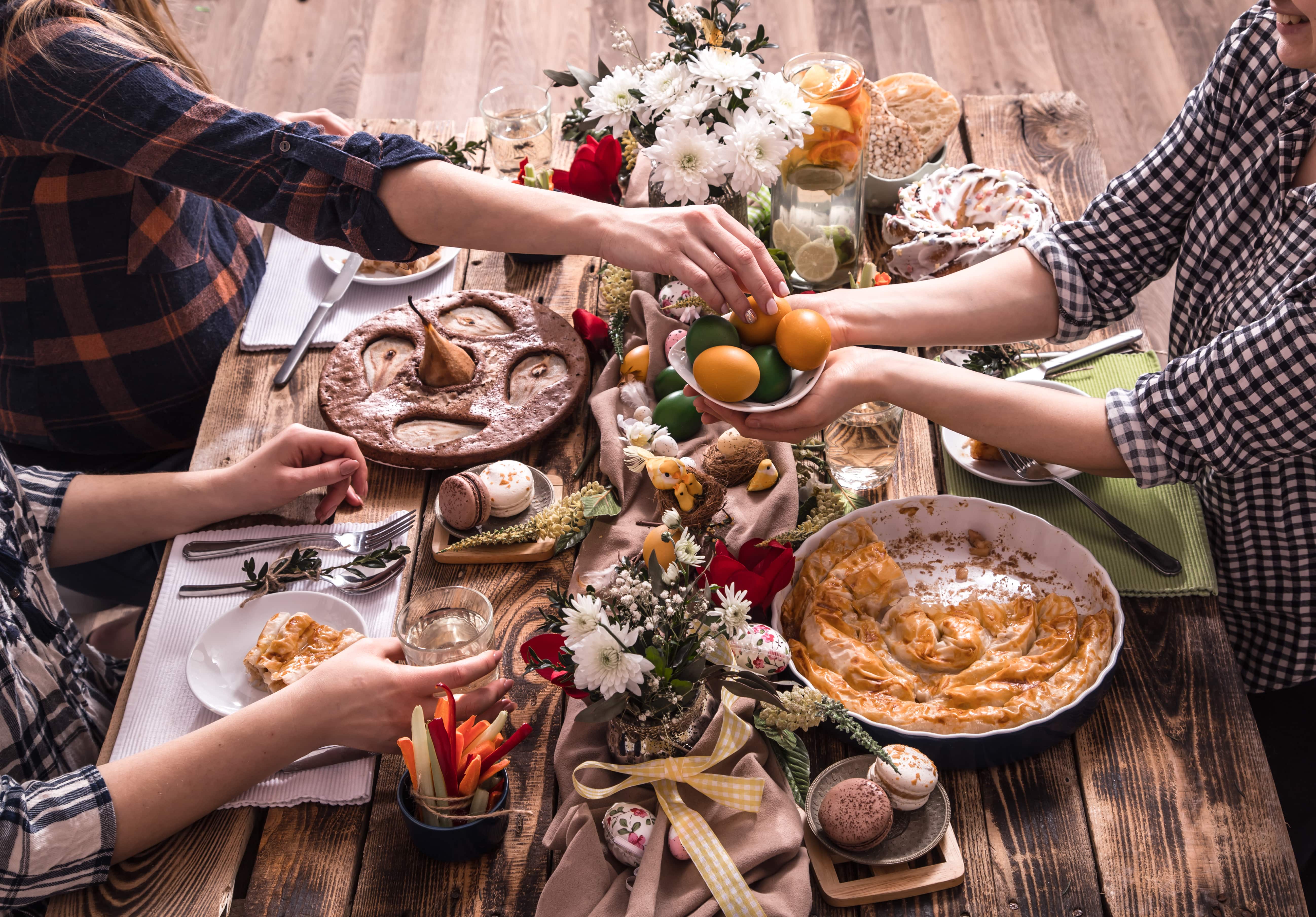Key Takeaways
- Eating a balanced Thanksgiving meal doesn’t need to be complicated. Using the Signos Plate Method makes it easy to adopt healthy holiday eating habits.
- Eat a combination of protein, complex carbs, and healthy fats at your holiday meal to promote post-meal glucose control.
- Meal sequencing, in which you eat foods in a specific order, also prioritizes metabolic health during the holidays.
that {{mid-cta}}
The holidays are here! It’s an exciting time of year filled with delicious food and fun traditions, but the classic Thanksgiving food you eat doesn't have to derail your metabolism. A balanced approach to your meal can ensure a blood sugar-friendly Thanksgiving that satisfies cravings while keeping energy levels steady.
The Metabolic Plate Concept

The way you create your plate can support metabolic health. The Signos Plate Method makes it easy to break up into different sections.
Half the plate is made up of non-starchy vegetables (anything besides potatoes, corn, peas, and winter squash), a quarter contains carbohydrates (whole grains, starchy vegetables, or fruit), and the remaining quarter has lean protein (such as turkey breast, chicken, fish, tofu, or legumes).
Creating a balanced Thanksgiving dinner benefits your blood glucose. This is because fiber from carbohydrates and non-starchy vegetables helps food digest more slowly. When food is digested more slowly, your blood sugar is more likely to stay steady.
Visualizing portion sizes makes it easier to lay out a balanced plate for healthy holiday eating. Use these protein strategies for blood sugar as you build your plate:
- The palm of your hand is equal to a serving of protein
- Your fist is about the size of a serving of carbs such as rice, fruit, or cereals
- Your cupped hand is equal to a half cup serving and can be used as a guide for potatoes, pasta, or desserts like ice cream
- A golf ball is about the size of two tablespoons. Picture half of that amount when adding fat-containing foods like butter, peanut butter, or salad dressing to your balanced Thanksgiving meal.1
Protein: The Foundation
Protein-containing foods are a key part of glucose-stabilizing meals. At Thanksgiving, the typical main dish is roast turkey, but eggs, tempeh, Greek yogurt, and chickpeas are also served.
Protein helps keep blood sugar steady by stimulating insulin secretion, which helps prevent blood sugar from rising too high. It also helps slow down food digestion.2
Fiber-Rich Vegetables and Complex Carbs

When it comes to Thanksgiving meal planning, seasonal veggies, legumes, and whole grains make nutritious additions.
Vegetables such as broccoli, parsnips, and winter squash are in season this time of year. Part of what makes veggies, as well as complex carbs like legumes and whole grains, so nutritious is their fiber content.
Fiber reduces post-meal glucose spikes. It helps slow the rate at which food empties the stomach and the rate at which glucose is absorbed into the blood.3
To create a balanced Thanksgiving meal, make these swaps for traditional Thanksgiving recipes:
- Prepare roasted sweet potatoes with cinnamon and pecans instead of serving sweet potato casserole with marshmallows and brown sugar. You could also swap butternut squash or acorn squash for sweet potatoes to add a more blood glucose-friendly dish to the Thanksgiving menu.
- In place of traditional green bean casserole, which is one of the most popular Thanksgiving side dishes, roast beans in the oven with olive oil, salt, black pepper, garlic, and slivered almonds. You can also top the roasted beans with fresh herbs. This will decrease your saturated fat intake, which the traditional casserole is high in.
- If you don’t care for green beans, make a roasted Brussels sprouts salad with olive oil, black pepper, and salt. When they’re nice and crispy, top with balsamic vinaigrette dressing, an apple, shallots, nuts, and lemon zest.
- Make stuffing with quinoa instead of white bread to increase fiber.
- Choose whole-wheat dinner rolls instead of white for a blood-sugar-friendly option.
- Serve cauliflower mash instead of mashed potatoes for post-meal glucose control.
- Finish the meal with baked apples instead of apple pie or pumpkin pie.
Healthy Fats and Flavor Boosters
Fat helps increase satiety, promotes nutrient absorption, and adds flavor to food. However, it’s important to choose heart-healthy fats, which benefit cholesterol levels and general heart health.
Polyunsaturated and monounsaturated fats are the kinds you want to eat more often. Limit saturated fat (found in foods like butter, cured meat, and ice cream) and avoid trans fat (found in fried foods, baked goods, and processed foods with hydrogenated oils).
Sources of monounsaturated fat include:
- Avocado
- Nuts and seeds
- Olive oil
Polyunsaturated fats are found in:
- Salmon
- Flaxseeds
- Walnuts4
Fat helps you feel full, which is known as satiety. Fat triggers the release of certain peptides that promote fullness, and one way we feel full is through slower stomach emptying. When food leaves the stomach slowly, blood sugar levels are likely to remain steady.5
Strategic Meal Sequencing and Portion Control

The order in which you eat affects blood glucose levels. Research shows that eating protein, fat, or fiber before carbs improves blood sugar after eating.6
At Thanksgiving, this could look like digging into the turkey breast or non-starchy vegetables before the stuffing, potatoes, or other carb-containing foods.
Part of maintaining metabolic health during holidays is being mindful about what you eat. Practice mindful eating by:
- Eating breakfast so you aren’t extremely hungry before lunch.
- Paying attention to portion sizes.
- Saving room for dessert so you aren’t uncomfortably full after your meal.
- Eat dessert with your meal so the fat, fiber, and protein can blunt blood sugar spikes.
- Create your plate with non-starchy veggies, lean protein, and complex carbs to naturally limit sugar and refined carbohydrates.7
How Signos Helps You Personalize the Plate

Thanksgiving is one of the highest-GV days of the entire year for Signos members, and the day after Thanksgiving isn’t far behind. Our latest spike data shows that glucose rises on these two days are consistently higher than average, which means your body may be more sensitive to larger meals, high-carb dishes, and holiday grazing than on typical days.
Signos helps you navigate all of this with clarity, not guesswork. With real-time data from your continuous glucose biosensor, you can see exactly how your holiday meal impacts your glucose, and make simple tweaks that keep you energized, satisfied, and in control.
Personalized Insights From Your Data
Your Signos app highlights how different Thanksgiving staples affect your body. You’ll see which combinations (like turkey, veggies, and a modest serving of potatoes) keep you in the purple “optimal zone,” and which lead to a yellow climb or a pink spike. Signos’ Weekly Insights and post-meal breakdowns help you spot patterns and make portion or sequencing adjustments to stabilize glucose, even on a high-variability day.
Smart Plate-Building Experiments to Try With Signos
- Protein-first experiment: Start with turkey before carbs. Compare your post-meal curve to days when you start with stuffing or rolls.
- Vegetable buffer test: Have a plate of greens or roasted veggies first and watch whether this blunts the spike from sweet potatoes or stuffing.
- Portion swap experiment: Use the Signos app to test half-serving vs. full-serving portions of carb-heavy dishes and see which keeps your curve smoother on a naturally high-GV day.
- Walk-and-watch: Take a 10–15 minute walk after your meal. Compare how quickly your glucose returns to purple vs. previous years’ holiday spikes.
- Dessert timing test: Have dessert 30–60 minutes after the main meal and compare that spike to having it immediately.
- Hydration helper: Drink water before or during your meal and observe whether this reduces the magnitude of your typical Thanksgiving spike.
Build a Plate That Works for You
With Signos, you can enjoy your favorite holiday dishes while still supporting your metabolism. The app helps you understand your unique glucose responses on a day when spikes are extremely common, so you can build a plate that keeps you steady, satisfied, and feeling your best through the celebration and the day after.
Learn More With Signos’ Expert Advice
Signos helps improve health by combining continuous glucose monitoring with support from registered dietitians, smart food logging, and insights into sleep and stress. Learn more about the role of blood glucose in overall health on Signos’ blog.
Topics discussed in this article:
References
- (n.d.). Estimating portion sizes using your hands. Southern Illinois University Edwardsville. https://www.siue.edu/campus-recreation/facilities/EstimatingPortionSizesUsingYourHands.pdf
- Mihai, B. M., Mihai, C., Cijevschi-Prelipcean, C., Grigorescu, E. D., , Dranga, M., Drug, V., Sporea, I., & Lăcătușu, C. M. (2018, October 3). Bidirectional relationship between gastric emptying and plasma glucose control in normoglycemic individuals and diabetic patients. J Diabetes Res. doi:https://doi.org/10.1155/2018/1736959
- Russell, W. R., Baka, A., Björck, I., Delzenne, N., Gao, D., Griffiths, H. R., & Weickert, M. O. (2016). Impact of diet composition on blood glucose regulation. Critical Reviews in Food Science and Nutrition, 56(4), 541–590. doi:https://doi.org/10.1080/10408398.2013.792772
- Heart Foundation. (n.d.). Fats, oils and heart health. https://www.heartfoundation.org.au/healthy-living/healthy-eating/fats-oils-and-heart-health
- López-Méndez, I., Maldonado-Rojas, A. D. C., Uribe, M., & Juárez-Hernández, E. (2023) Hunger & satiety signals: another key mechanism involved in the NAFLD pathway. Front. Endocrinol. 14(1213372). doi: 10.3389/fendo.2023.1213372
- Kubota, S., Liu, Y., Iizuka, K., Kuwata, H., Seino, Y., & Yabe, D. (2020). A review of recent findings on meal sequence: An attractive dietary approach to prevention and management of type 2 diabetes. Nutrients, 12(9), 2502. https://doi.org/10.3390/nu12092502
- Hall, R. (2024, November 18). Holidays: Tips for mindful eating this Thanksgiving. University of Arkansas Cooperative Extension Service. https://www.uaex.uada.edu/media-resources/news/2024/november/11-18-2024-ark-thanksgiving-mindful-eating.aspx




.svg)










.svg)
.svg)
.svg)
.svg)
.svg)
.svg)
.svg)
